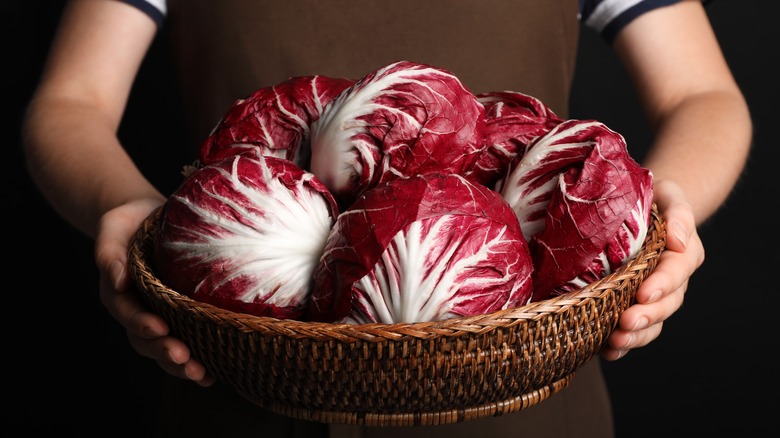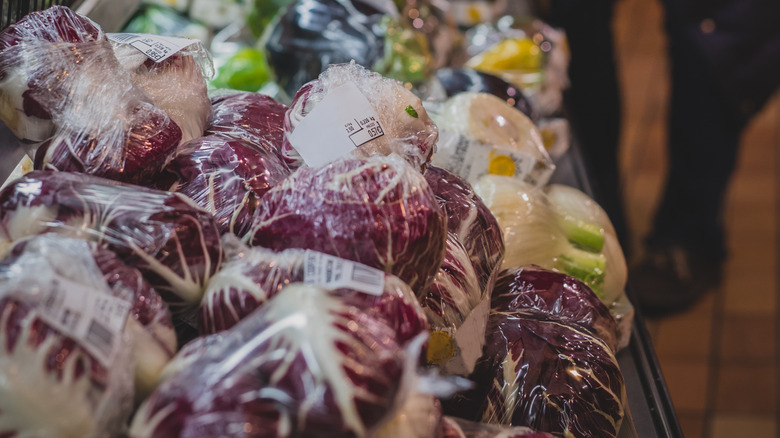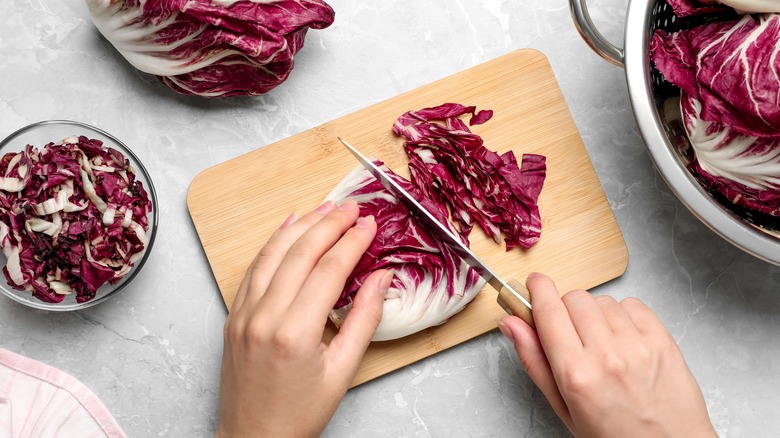The Best Way To Store Radicchio For Maximum Freshness
Radicchio is a hearty vegetable that is often compared to cabbage or lettuce, but it's actually a member of the chicory family, alongside greens like endive and escarole. Like many "greens" (though radicchio is reddish-purple), this slightly bitter veggie tastes tastes amazing in salads, but you can also grill or roast it for a delicious smoky flavor. Plus, it has a longer shelf life than many other veggies, and can last for up to three weeks in the fridge. The downside is that a head of radicchio's outer leaves may soften or turn mushy after just a few days.
One solution to this problem is to buy a head of radicchio with the root attached, which can help a head last for several months. But if you buy radicchio from the grocery store, all you can do to extend its life is to store it carefully. First, put it in a perforated plastic bag to keep it fresh for longer. Unlike a plastic bag with no holes or openings, perforated bags help to maintain optimal moisture levels, so the radicchio's crunchy texture lasts for longer. Another option is to wrap the radicchio in paper before refrigerating it to preserve its crispiness. Either way, this veggie must be stored in the fridge.
Store radicchio in a perforated bag to keep it fresh
Radicchio may not be in the lettuce family, but just like lettuce, it's prone to moisture-related decay, such as like wilting or mushiness. If you wrap a head of radicchio in plastic, the bag can accumulate moisture inside and result in mold growth. Meanwhile, the openings in a perforated plastic bag create proper airflow and allow moisture to escape, preventing condensation from building up around your radicchio. You can buy these bags from your local grocery store or poke a few holes in a regular plastic bag. Note that the outer leaves may become wilted or blemished over time, but you can discard them and use up the rest.
Store radicchio in the fridge, ideally at 32 to 36 degrees Fahrenheit. Keep it away from ethylene-producing fruits and vegetables, such as apples, pears, tomatoes, avocados, and peppers. Ethylene gas is the reason some fruits ripen after picking, but as the gas is released, it can cause other produce in close proximity to over-ripen and rot. Radicchio may develop brown spots, discoloration, and fungal decay within days of being stored near ethylene-producing foods. Lastly, only wash the veggie right before you cook or eat it — washing in advance adds excess moisture, which again, causes decay.
Radicchio doesn't freeze well
You may think that freezing radicchio is a surefire way to extend its shelf life, but think again. Some vegetables and other frozen foods last a surprisingly long time, but radicchio isn't one of them. This member of the chicory family doesn't freeze well, and once thawed, may lose its flavor and vibrant color, in addition to turning soft and soggy.
Radicchio tastes best when eaten fresh, so make plans to use it up before it goes bad. The leaves can be a wonderful addition to seasonal salads, homemade pizza, sandwiches, and meat dishes. For example, you could make a creamy risotto with dried plums and radicchio and serve it for lunch or dinner. Another option is to braise radicchio in wine or chicken stock for a hearty dish that feels more substantial.
If you're feeling creative, blend leftover radicchio with garlic, pine nuts, parmesan cheese, olive oil, and herbs to make a flavorful pesto. You can also mix radicchio with thinly-sliced apples and serve with a dressing made of yogurt, mustard, honey, and lemon juice. For a light dinner, try this delicious salad with radicchio, spinach, and grapefruit. It's big enough to feed six people and can be enjoyed as-is, or served with grilled fish, steak, or poultry.


